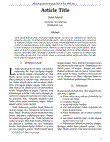Resultados de búsqueda - Sèvres~
Materias dentro de su búsqueda.
Materias dentro de su búsqueda.
- 36
- México 16
- Mexico 10
- depresión 10
- educación 10
- género 10
- COVID-19 9
- Nuevo León 9
- education 9
- estudiantes 9
- Innovación 8
- Covid-19 7
- Educación 7
- M12 7
- derechos humanos 7
- educación superior 7
- innovación 7
- innovation 7
- Calidad 6
- Economía 6
- Educación Superior 6
- Inteligencia Artificial 6
- democracia 6
- estrés 6
- estrés laboral 6
- gender 6
- mujeres 6
- redes sociales 6
- Artificial Intelligence 5
- Bienestar 5
-
3781
-
3782
PREFERENCIA DE Aedes aegypti y Culex quinquefasciatus POR SITIOS DE REPOSO INTRA Y PERIDOMICILIO EN MONTERREY, N. L., MEXICO
Publicado 2010“…Las variables: humedad relativa, temperatura y color, se encuentran estrechamente ligadas (asociadas), con la presencia de cada una de las dos especies. Abstract Sixty seven houses within the Monterrey, Nuevo Leon metropolitan area were randomly selected; to analyze for differences in indoor and house perimeter resting sites preference between Aedes aegypti and Culex quinquefasciatus. simple correspondence and conglomerate analysis were used to determine degree of dependence and likeness between resting sites and number of collected specimen.s Results showed that Ae. aegypti has preference for bathrooms and dark surfaces to rest, at a temperature of 30-35°C and 50-60% humidity. …”
Enlace del recurso
Artículo -
3783
-
3784
-
3785
-
3786
-
3787
-
3788
-
3789
-
3790
-
3791
Aceptación y uso del Marketing Digital en el Sector Inmobiliario en Nuevo León
Publicado 2019Enlace del recurso
Artículo -
3792
-
3793
-
3794
Implementación de la metodología del plan de negocios en mipyme “Zona Green”
Publicado 2018Enlace del recurso
Artículo -
3795
A systematic review of shared decision making interventions in chronic conditions: a review protocol
Publicado 2014“…We will evaluate outcomes according to an importance ranking informed by a variety of stakeholders. We will perform several exploratory analyses including the effect of author contact on the estimates of effect. …”
Enlace del recurso
Artículo -
3796
Latin America: the next region for haematopoietic transplant progress
Publicado 2017“…Collated responses were compared with data of transplant rates from the Worldwide Network for Blood and Marrow Transplantation for other geographic regions. Several socio-economic variables were analysed to determine correlations with transplant rates. …”
Enlace del recurso
Artículo -
3797
Control reproductivo y larvario del catan (Atractosteus spatula)
Publicado 2006“…Spawning grounds have also been damaged by urban and agricultural expansion and the construction of dams. Since 1982 several efforts have been made to accomplish their reproduction in captivity to overcome the limited supply of larvae. …”
Enlace del recurso
Tesis -
3798
Bacillus thuringiensis como agente de control biológico del complejo de la marchitez del chile (Capsicum annuum L.)
Publicado 2009“…Forty four different localities and several types of pepper were sampled in Durango State, where the presence of several pathogenic fungi to pepper production was observed; being more frequently isolated R. solani, Fusarium spp., Verticillium spp., Colletotrichum spp., Sclerotium spp. and P. capsici. …”
Enlace del recurso
Tesis -
3799
Control reproductivo y larvario del catan (Atractosteus spatula)
Publicado 2006“…Spawning grounds have also been damaged by urban and agricultural expansion and the construction of dams. Since 1982 several efforts have been made to accomplish their reproduction in captivity to overcome the limited supply of larvae. …”
Enlace del recurso
Tesis -
3800
Bacillus thuringiensis como agente de control biológico del complejo de la marchitez del chile (Capsicum annuum L.)
Publicado 2009“…Forty four different localities and several types of pepper were sampled in Durango State, where the presence of several pathogenic fungi to pepper production was observed; being more frequently isolated R. solani, Fusarium spp., Verticillium spp., Colletotrichum spp., Sclerotium spp. and P. capsici. …”
Enlace del recurso
Tesis


